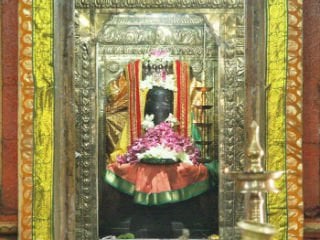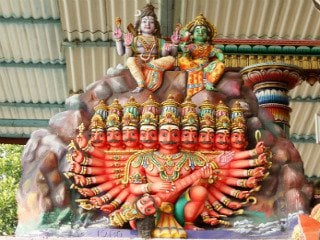
The temple of Dhareshwar in Dhayari village is worth a vision at dawn or twilight. The road leading to it is surrounded by Audumbar (Holy fig), peepal and other trees. There is ample shade on both sides as you climb the steps to the temple. As you catch a glimpse of the Shivalinga in the sanctum sanctorum of the temple you unconsciously tend to fold your hands in obeisance. Dhareshwar temple is spread over an area of 4.5 acres.
The present temple was constructed in 1978. The surroundings of the temple are lush green. Locals visit the Khandoba temple on the mountain behind this temple intermittently. Shri Dhareshwar temple is 350 years old. Many people belonging to the Raikar family live in the village of Dhayari. Shri Jaitujibaba Raikar from this family, a pious soul, constructed this temple out of his intense devotion unto Deity Shiva. Presently the temple is being managed by the Shri Dhareshwar Mahadev Sansthan. The legend underlying this temple is as follows.
The primal member of the Raikar family, Jaitujibaba, was a devotee of Deity Shiva. He would go to Shikhar Shignapur (a place of worship) in Satara District every morning, to pay obeisance and return home by evening. One day when returning it became dark. He was frightened but Bhagwan Shiva disguised as a hermit appeared before him and said ‘Do not fear. I am with you. Only do not look behind till we reach your home.’ Hearing this, Jaitujibaba set out. When he reached the spot of the present day Dhareshwar temple he thought ‘I have now reached my village, I can now turn and look behind’. When he turned back, he saw Deity Shiva was standing there in the form of a hermit. The next moment He vanished. Shivalingas exactly like those from Shikhar Shignapur manifested there.
Then Jaitujibaba constructed a small temple there. After some time, he became very weak and he could not walk up to the temple. Therefore, he would chant at his residence and offer water (as abhishek) on the ground. Lingas sprung even there. Today his residence is known as Devwada (The Divine abode).
Later he began to contemplate on taking samadhi (to renounce the body through a state of meditation) when alive and hence asked his sons to dig a pit. When the sons dug the first pit a Shivalinga manifested there. This continued with every pit that they dug, seven times. The sons reported this incident to their father. Then Jaitujibaba prayed after which in the 8th pit which was dug Shivalinga did not appear and Jaitujibaba was able to take samadhi in it. Those seven lingas and the living samadhi is visible even today. If you climb a little higher on the right, you can see a Shani temple. Though the idol is old its installation was done only about 5 years ago. On climbing the main steps, you find two huge lamps welcoming you. The Nandi between the two lamps faces the Shiva temple located on a large piece of land.
The hall too is huge and clean and Deity Shiva’s devotees are seen performing chanting there. One cannot stop oneself from offering obeisance on seeing the beautiful linga from the sanctum sanctorum. There is a continuous flow of water from a copper vessel onto the linga. This seat has been created through the devotion of Jaitujibaba unto Deity Shiva. At 6 a.m. daily worship and abhishek is performed in this temple. There is arti again at 7.30 p.m. The temple is closed for devotees between 12 noon and 4 p.m.
There is a huge pilgrimage of Shri Dhareshwar on Chaitra Vadya 4 (4th day of the bright fortnight of Hindu lunar month of Chaitra). Planning for this event is done on the day of Gudhi Padwa (Hindu New Year). The Holy stick or yoke of Mahadev leaves for Shikhar Shignapur on the 8th day after Padwa. Shignapur situated on the outskirts of Dhayari village is the first seat to receive this honour. Chhatrapati Shivaji Maharaj has inscribed this in his copper inscription plate. The Holy yoke returns to the original temple after 12 days. Arrangements for stay etc. of all those accompanying this Holy yoke is done by the Sanstha. After the return of the Holy yoke there is a lot of celebration with bhajans, kirtans, discourses etc. creating an atmosphere of devotion. There is a temple of Deity Datta in the shade of a Holy fig tree behind the main Dhareshwar temple. A temple of Akkalkot Swami was constructed next. The entire area is very pleasant.
Holy texts and sattvik products produced by Sanatan are exhibited and sold at a stall in the compound of this self-manifested temple amidst natural beauty, on Mahashivaratri, for the benefit of devotees. An earnest prayer at the Holy feet of Shri Dhareshwar is to endow people with the strength to perform spiritual practice required for protection of the nation and Dharma.

 The Amarnath Yatra that bestows humans with the merit of visiting 23 holy places of...
The Amarnath Yatra that bestows humans with the merit of visiting 23 holy places of... Banteay Srei : The Deity Shiva temple in Phnom Dei village, Cambodia
Banteay Srei : The Deity Shiva temple in Phnom Dei village, Cambodia Shri Dev Kunkeshwar : The Kashi of Konkan
Shri Dev Kunkeshwar : The Kashi of Konkan Spiritual experiences of Shrichitshakti (Mrs) Anjali Gadgil after taking darshan of Shri Vaidyanatheshwar Shiva at...
Spiritual experiences of Shrichitshakti (Mrs) Anjali Gadgil after taking darshan of Shri Vaidyanatheshwar Shiva at... The Shivalinga from the Naguleswaram temple in Srilanka worshipped by Shrirama to nullify the sin...
The Shivalinga from the Naguleswaram temple in Srilanka worshipped by Shrirama to nullify the sin... The Thirukoneshwaram temple in Srilanka known as ‘Dakshin Kailas’
The Thirukoneshwaram temple in Srilanka known as ‘Dakshin Kailas’